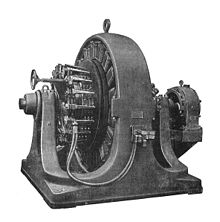Rotary converter

A rotary converter is a type of
Rotary converters were used to convert
Principles of operation


The rotary converter can be thought of as a
The device can be reversed and DC applied to the field and commutator windings to spin the machine and produce AC power. When operated as a DC to AC machine it is referred to as an inverted rotary converter.
One way to envision what is happening in an AC-to-DC rotary converter is to imagine a rotary reversing switch that is being driven at a speed that is synchronous with the power line. Such a switch could rectify the AC input waveform with no magnetic components at all save those driving the switch. The rotary converter is somewhat more complex than this trivial case because it delivers near-DC rather than the pulsating DC that would result from just the reversing switch, but the analogy may be helpful in understanding how the rotary converter avoids transforming all of the energy from electrical to mechanical and back to electrical.
The advantage of the rotary converter over the discrete motor-generator set is that the rotary converter avoids converting all of the power flow into mechanical energy and then back into electrical energy; some of the electrical energy instead flows directly from input to output, allowing the rotary converter to be much smaller and lighter than a motor-generator set of an equivalent power-handling capability. The advantages of a motor-generator set include adjustable
In this first illustration of a single-phase to direct-current rotary converter, it may be used five different ways:[5]
- If the coil is rotated, alternating currents can be taken from the collector rings, and it is called an alternator.
- if the coil is rotated, direct current can be taken from the commutator, and it is called a dynamo.
- If the coil is rotated, two separate currents can be taken from the armature, one providing direct current and the other providing alternating current. Such a machine is called a double current generator.
- If a direct current is applied to the commutator, the coil will begin to rotate as a commutated electric motor and an alternating current can be taken out of the collector rings. This is called an inverted rotary converter (see inverter).
- If the machine is brought up to synchronous speed by external means and if the direction of the current through the armature has the correct relationship to the field coils, then the coil will continue to rotate in synchronism with the alternating current as a synchronous motor. A direct current can be taken from the commutator. When used this way, it is called a rotary converter.
Self-balancing dynamo
The self-balancing dynamo is of similar construction to the single- and two-phase rotary converter. It was commonly used to create a completely balanced three-wire 120/240-volt AC electrical supply. The AC extracted from the slip rings was fed into a transformer with a single center-tapped winding. The center-tapped winding forms the DC neutral wire. It needed to be driven by a mechanical power source, such as a steam engine, diesel engine, or electric motor. It could be considered a rotary converter used as a double current generator; the alternating current was used to balance the DC neutral wire.
History

The rotary converter was invented by
Rotary converters soon filled the need to use all the competing electric power delivery systems that cropped up in the 1880s and early 1890s. These included single phase AC systems, poly-phase AC systems, low voltage incandescent lighting, high voltage arc lighting, and existing DC motors in factories and street cars.[7][8] Most machinery and appliances at that time were operated by DC power, which was provided at the user level by rotary converter substations for residential, commercial and industrial consumption. Rotary converters provided high current DC power for industrial electrochemical processes such as electroplating. Steel mills needed large amounts of on-site DC power for their main roll drive motors. Similarly, paper mills and printing presses required direct current to start and stop their motors in perfect synchronization to prevent tearing the sheet.
Obsolescence
The stopgap of needing to use rotary converters was slowly overcome as older systems were retired or upgraded to match the newer AC universal system. AC to DC synchronous rotary converters were made obsolete by
AC replaced DC in most applications and eventually the need for local DC substations diminished along with the need for rotary converters. Many DC customers converted to AC power, and on-site solid-state DC rectifiers were used to power the remaining DC equipment from the AC supply.
See also
- Cascade converter
- Frequency converter
- Motor–generator
- Rotary converter plant
- Rotary phase converter
- Three-phase electric power
- Traction current converter plant
References
- . Retrieved 2022-11-15.
- ^ Hawkins Electrical Guide, 2nd Ed. 1917, p. 1459, fig. 2034
- ^ Hawkins Electrical Guide, 2nd Ed. 1917, p. 1460, fig. 2035
- ^ Hawkins Electrical Guide, 2nd Ed. 1917, p. 1461, fig. 2036
- ^ Hawkins Electrical Guide, 2nd Ed. 1917, p. 1461
- ^ Hughes, Thomas Parke. Networks of Power: Electrification in Western Society, 1880–1930. Baltimore, Maryland: Johns Hopkins University Press - 1993, pp=120–121
- ^ Garud, Raghu; Kumaraswamy, Arun; Langlois, Richard (2009). Managing in the Modular Age: Architectures, Networks, and Organizations. New York: John Wiley & Sons. p. 249
- ^ Hughes, Thomas Parke. Networks of Power: Electrification in Western Society, 1880–1930. Baltimore, Maryland: Johns Hopkins University Press - 1993, pp=120–121
- ^ ISBN 978-1568983554.
- Slichter, W.I. (1917). "Converters, Synchronous or Rotary". In Pender, Harold (ed.). Handbook for Electrical Engineers. New York: John Wiley & Sons. pp. 279–291.
- Greenberg, Bernard S. (1999). "Rotary Converter Power Technology: AC, DC, and Subway Power." nycsubway.org.
